Page Content
- Sinkholes in the Dead Sea Basin
- Solar Energy
- Dead Sea Canal
- Red Sea – Dead Sea Canal Project
- The Dead Sea as a Biosphere Reserve
The amount of water supplied by the River Jordan, the streams and the floodwaters on both sides of the Dead Sea, does not equal the high evaporation rate on the lake. This problem, unfortunately, is also due to man’s intervention. Plans are required to prevent deterioration of the Dead Sea.
Much of the water supplied by tributaries has been diverted for the water required for drinking and agriculture by the adjoining countries.
Together with natural evaporation, this has caused the Dead Sea water level to diminish more than one meter a year.
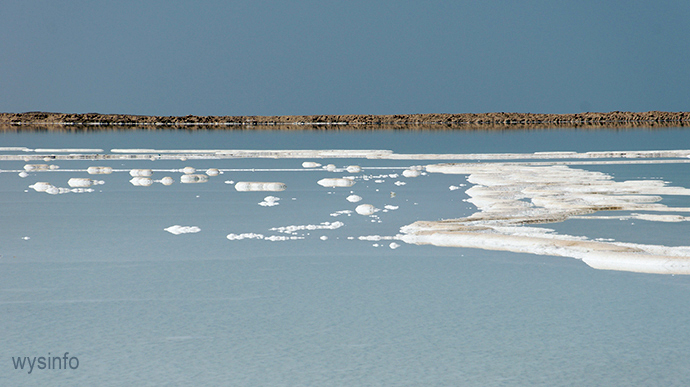
Reversing this problem means that people will either have to stop using the water of the tributaries, or will have to bring water into the Dead Sea from a different source. The latter solution could also support other projects such as the generation of electricity using solar energy and/or a potential height difference, water desalination and tourism.
Sinkholes in the Dead Sea Basin – A Need for Action
One of the alarming results of the drop in the Dead Sea water level is the creation of sinkholes along the shore line. This phenomenon has caused severe damage to property and, in some cases, has even resulted in accidents. There is a need for generating plans to prevent this deterioration resulting in sinkholes beside the Dead Sea.
What causes sinkholes beside the Dead Sea?
The sinkholes occur in areas where the regressing sea have left layers of salt underneath the soil. Fresh water from the springs dissolve the layers of salt to a point that the upper non-salty layer becomes thinner and sinks.
Some of the holes reach a size of about 40 meters in diameter and some have reached a depth of about 25 meters. More than a thousand sinkholes have already been identified and more are being created. This emphasizes the need to raise the sea level and the sooner the better.
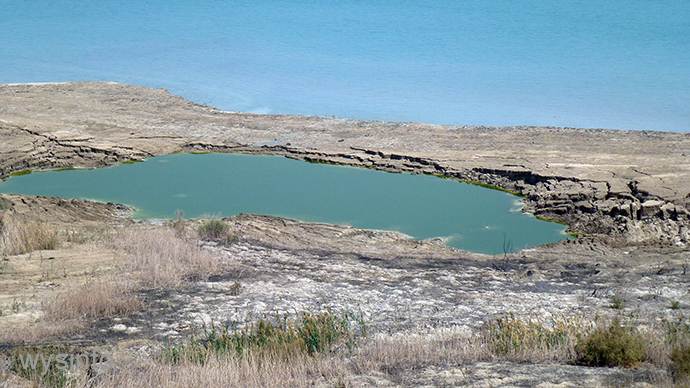
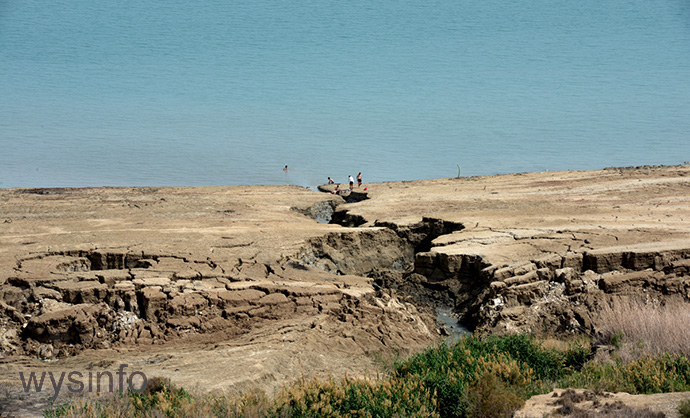

Solar Energy Plans for the Dead Sea
Experiments on exploitation of solar energy were successfully conducted in the Dead Sea region for some time. These were based on an interesting phenomenon that exists in very few places on earth.
The sun rays, striking a shallow body of water, penetrate to the bottom, are absorbed, and cause the water to warm up. The lighter, warm water rises and discharges its heat into the air; then it cools and descends once more.
But when the water body contains salts at a concentration which gradually increases with depth, the warm water at the bottom cannot rise owing to its high specific gravity.
In this case, a kind of hothouse forms. The sun rays penetrate the top layers of water. The bottom layer absorbs the rays and stores them there. The lower layer of water, with its uniform salinity, acts as a large heat accumulator and is able to store it for a lengthy period.
Heat loss is minimal since the bottom insulates below and the water, a poor heat conductor, insulates above.
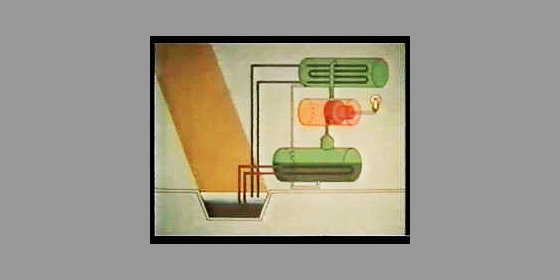
Solar ponds are based on this physical principle, with the addition of a technique that is brilliant in its simplicity.
Dead Sea solar energy plant experiment
Ormat, an Israeli company, created an experimental solar pond in the 1980’s. The pond consisted of three layers of water. The system pumped the warm water of the bottom storage layer, through pipes, to a heat converter. The converter consisted of a network of tubes containing an organic material with a very low boiling point.
The vaporized organic fluid turned turbines. These connected to a generator that created electricity. The vapor reached a condenser activated by the cold water of the top layer of the pool. This cooled the organic fluid, which then returned to the vaporizer for repeat use.
The warm water in the vaporizer boiled the organic fluid, then cooled and descended to the lowest layer of the solar pool. There it was heated up once more.
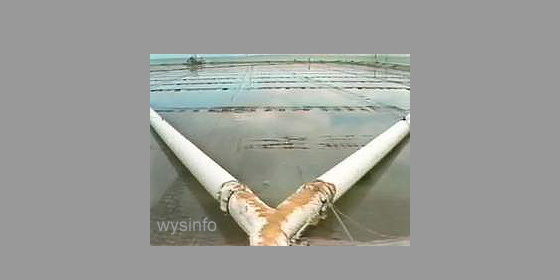
Nets cast over the surface of the pool prevented the formation of waves by wind in order to avoid the mixing of layers of different density. This kept the water surface smooth.
The trial plant, by the shores of the Dead Sea, demonstrated the idea. It was able to provide 150 kw/h of electricity without pollution and by means of solar energy, from a pool area of 7000 m2.
A larger implementation of the process by the Dead Sea, should be able to supply the needs of electricity to the Jordanian settlements as well as to the Israeli settlements around the Dead Sea. This, however, requires a political agreement, vision and good will from the leaders of the countries involved.
It is possible to combine such a project with a far greater project for the sake of nature and the people of this area, such as the Mediterranean-Dead Sea Canal, or alternatively, the Red Sea-Dead-Sea Canal.
A Dead Sea Canal
Calculations have shown that a solar pool the size of the Dead Sea could supply more than the energy needs of Israel. The establishment of a large-scale plant requires a considerable amount of water of fairly low salinity for the purpose of creating layers of gradually increasing salt concentrations.
A canal, planned to link the Mediterranean and the Dead Seas, could supply enough water to operate a solar pool large enough to produce a major part of Israel’s electricity needs.
History of Plans for a Dead Sea – Mediterranean Canal
Already at the end of the 19th century there was an idea for a canal joining the Mediterranean to the Dead Sea to exploit the height difference between them to generate electricity . The idea was voiced again several times over the years but rejected.

After the energy crisis of 1973 and the increasing need to exploit alternative sources of energy, the economic feasibility of this project grew, with ramifications extending far beyond the mere production of electricity.
There was a decision to implement the project taken already then. Of the five alternatives examined it seemed that the route through Tel Katif, Halutza to Massada was the best.
The 1973 plan for the Dead Sea – Mediterranean Canal
The plan envisioned a combination of a tunnel, canal and reservoirs that would start at the Mediterranean coast and end at the base of a cliff facing the Dead Sea. It would include an intake plant, off the Mediterranean, about 600 meters out to sea. Based on this plan, pumps would control the flow of 50 cubes of water a second through a seven-meter long pressure pipe to a height of 100 meters above sea level. From there the water would flow in an open canal 20 meters wide to a distance of 22 kilometers.
Next the water would enter a tunnel five meters in diameter and 86 kilometers long and would flow east. South of Massada, on the Judean Plateau overlooking the Dead Sea, two reservoirs would be built. These would serve the power station for use at peak consumption hours. The station would be built into the cliff facing the Lissan peninsula, which meanwhile would be connected to the shore.
The water would fall from a height of about 400 meters through a pressure pipe and would turn the four turbines of the station. According to the plan, this would produce 450 megawatts of electricity. The station was planned to operate at peak hours and would produce electricity without pollution. The project would be worthwhile, even if the only benefit was the generation of electricity. But there are also notable side benefits. What are these?
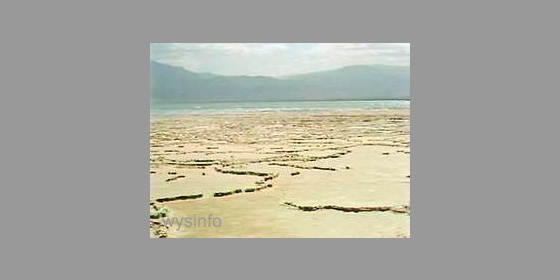
Reversing the problem of a shrinking Dead Sea
For years the level of the Dead Sea has gradually fallen on account of the tremendous evaporation and man’s intervention. The use of the Jordan waters and its resources, both by Israel and by Jordan’s diversion of the Yarmuk river, have affected the current state of the sea.
The water level has continuously dropped by at least one meter every year. The inflow of Mediterranean water would allow control of the elevation of water. It could bring it to its original level and maintain it there. Because of the difference in salinity, the Mediterranean water would allow implementation of the solar pool project, this time on a large scale.
Additional benefits – promoting marine agriculture / tourism
The project would furthermore provide water to wash away the salt that has crystallized in the ponds of the Dead Sea Works. This would promote Marine agriculture by creating ponds for fish, crabs and algae built next to the power stations.
It would supply cooling water for the power stations planned for the interior of Israel. This would relieve the pressure on the Mediterranean coast that could then be developed for summer resorts and tourism. The project would create the effect of an oases for desert tourism and recreation.
From the economic and professional viewpoint the advantage of the project was in the fact that its sole raw material – water – is available, and therefore there is no dependence on outside suppliers.
The project envisaged raising the level of the Dead Sea without flooding the Dead Sea Works or harming the Jordanian potash plant. The plan envisioned a replenishment phase, which would last five to twelve years, and a stabilizing phase, lasting about 40 years. Together this covers half a century, the life span of the project.
Controversy and re-assessment – electric plant or desalination
The plans for a Dead Sea canal were not without controversy. A re-assessment of the project was done during the early 90’s. It argued that, from an economic point of view, exploitation of the potential height difference would be more valuable for desalinating water rather than only generating electricity.
Red Sea – Dead Sea Canal Project
Political circumstances raised the idea of using alternative plans for the Mediterranean-Dead Sea canal. These plans involved creation of a canal and a series of projects between the Red Sea to the Dead Sea.
This would have also helped to incorporate political advantages as well as economic ones, by creating mutual interests and obligations for adjoining countries. A Dead Sea – Red Sea Canal project would have to be an Israeli-Jordanian-Palestinian joint venture.
The World Bank financed a feasibility survey for this project and in February 2016 Israel and Jordan signed an agreement for actualizing it. Under this agreement 4 pipes would carry water from the Red Sea to the Dead Sea. During the first stage of the project a 180 km pipeline was planned to be built between the 2 seas. This pipeline would carry approximately 200 million cubic meters a year and would be used in part to fill up the shrinking Dead Sea and in part for desalination purposes.
The plan envisioned a desalination plant in Aqaba in Jordan. Israel would receive a certain amount of the desalinated water for the use in the south of the country. Jordan would receive, on top of what it currently gets, an equal amount from the Sea Of Galilee.
There is no doubt that any project, if undertaken, would require the cooperation of all parties. The final decisions rest in the hands of the politicians. Regardless of the approach, it is necessary to look at the area as a whole.
The Dead Sea as a Biosphere Reserve
The Dead Sea basin is unique in terms of geology and nature. In addition, it holds archeological and historical importance for mankind. This has stimulated the Friends of the Earth Middle East-EcoPeace (FoEME) to come up with a stand regarding the Dead Sea basin.
There is a need, they say, for a different approach. They favor holistic plans for the Dead Sea that support an integrative concept for regional sustainable development. Registering the Dead Sea basin as a Biosphere Reserve with UNESCO, according to FoEME, will result in international recognition for the Dead Sea as a site of global significance and as a site in need of protection.
Filling up the draining Dead Sea should be done, according to the FoEME, by reviving the Jordan river. This also will regenerate the flora and fauna that existed there. They call for balancing the need of man and nature.
Whether this becomes a reality depends on the leaders of the countries involved. With the active political support of the international community it could serve as an example for other nations. It could show that co-operation between countries would result in a better planet for future generations.
Related Link – A Pre-Feasibility Study on Water Conveyance Routes to the Dead Sea
